Plaintiff Trial Lawyers Attempt to Distort Role of Judges and Juries
This spring’s decisive Republican primary victories by the highly qualified Texas Supreme Court incumbents, though satisfying, left a battlefield marked with signs that the plaintiffs’ trial bar has no plans to abandon their assault on the high court. The key sign was their decision to cross over and begin supporting Republican candidates—proven trial lawyer allies, of course. Another was their sly mimicry of populist themes.
A toxic myth that distorted the role of judges and juries proved the trial lawyers’ most cunning weapon. Hearing their rhetoric, faithfully repeated by their few Republican allies and hand-picked candidates, one might think that every lawsuit reversed on appeal represents an assault on democracy. The populist allure is no accident. After all, when there is a jury verdict, haven’t the people spoken? Shouldn’t their verdict stand?
Since appeals often seem obscure and complex, babble like this can sound plausible. However, by constitution, the Texas Supreme Court does not sit as a supreme jury. It can set aside a jury verdict only because of an error of law by the trial judge or in the extremely rare case of a verdict supported by no evidence at all. The fourteen intermediate courts of appeals have one additional constitutional power: to set aside a verdict so opposed to the evidence that no reasonable jury could reach it. Otherwise, appellate courts cannot simply overturn a jury verdict based on correctly defined law and credible evidence. This preserves the Texas constitutional principle that “the right of trial by jury shall remain inviolate.”
Fortunately, the jury verdict myth fomented by the trial lawyers was not enough to make many Texas voters forget the bad old days of the 1980’s when plaintiff lawyers took over the Texas Supreme Court and launched a wave of radical pro-plaintiff decisions. It took years of legislative advocacy and hard-fought political campaigns before we were able to return sanity to the court system and cure the damage to the reputation and business climate of the state.
This year’s triumph does not assure future victory. Their immense financial resources have allowed the trial lawyers to worm their way into the Republican Party. There is no reason to believe they will give up anytime soon.
The trial lawyers will never give up this fight, and neither can we. To preserve our freedom from oppressive lawsuits, we need to recall what Thomas Jefferson identified as the price of liberty: eternal vigilance.
TLR Co-Founder & CEO Dick Weekley Honored for Public Policy Accomplishments
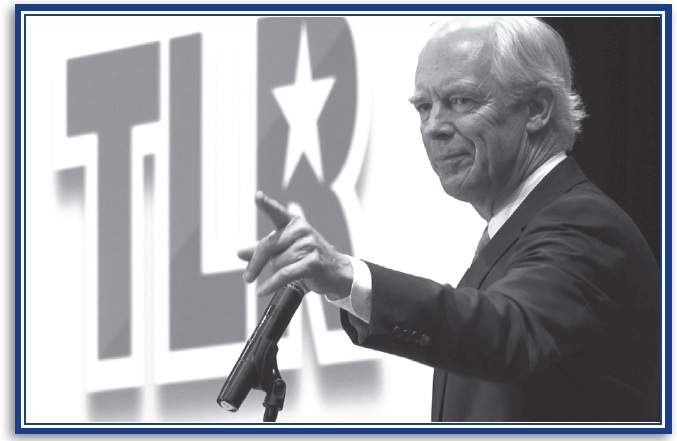
The Texas Business Leadership Council (TBLC) honored TLR Co-Founder and CEO Dick Weekley with the organization’s inaugural Public Policy Leadership Award in Houston last month. The keynote address for the award dinner was given by U.S. Senator John Cornyn (R-Texas).
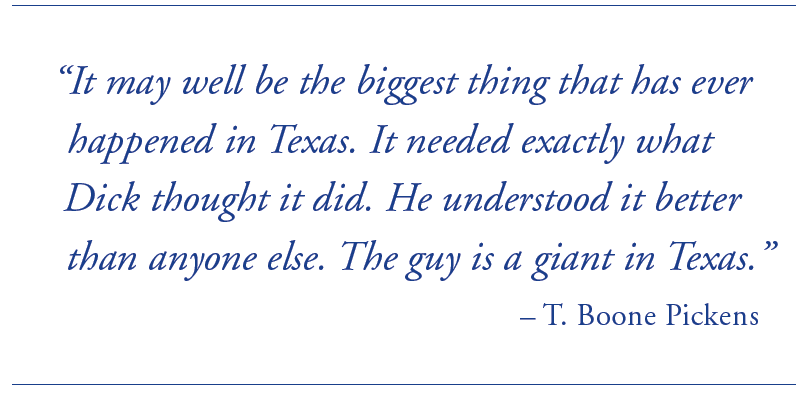
TBLC Chairman Jodie L. Jiles presented Weekley with the award saying, “Dick Weekley exemplifies the best in public policy advocacy. He’s a true Texas trailblazer, and a business leader with a thorough understanding of the complex issues affecting our state. Time and again, Dick has stepped up to offer his keen insight and thoughtful policy perspective in the interest of creating a Texas that’s a beacon for job creation, investment and economic growth.”
Jiles announced that the award going forward would be known as the Richard W. Weekley Public Policy Award.
A video presentation at the award dinner included acknowledgements of Weekley’s pioneering work in lawsuit reform from former President George W. Bush and Gov. Rick Perry, who called Weekley “a Texas hero.
“The presentation highlighted Weekley’s work beginning twenty years ago in establishing Texans for Lawsuit Reform. Woody Hunt, TLR supporter and past chairman of the Texas Business Leadership Council said:
“Dick Weekley’s work is the most remarkable example of business leadership being involved in public policy in a way that has a really significant positive impact, not only on Texas but across the U.S. as others try to replicate our policies that have created a strong economy. Dick’s work on tort reform and education reform stand out among a wide range of issues that he’s been deeply and personally engaged.”
Recalling how TLR first began, TLR General Counsel, Hugh Rice Kelly said,
“We were all bound up in frustration in the early 1990’s about how bad our litigation system was and what a hellhole Texas had become and how the plaintiff lawyers were running everything. And people were complaining. Weekley decided something had to be done.”
Other accolades from TLR supporters from around the state were included in the video:
Longtime TLR supporter Harlan Crow of Dallas said: “Dick gets credit for figuring out a terrible situation which our whole country is facing, but we were facing in the worst way in Texas. And then just systematically, assiduously, relentlessly figuring out the right solutions, the moral solutions to solve a big problem and then setting about systematically to do that.”
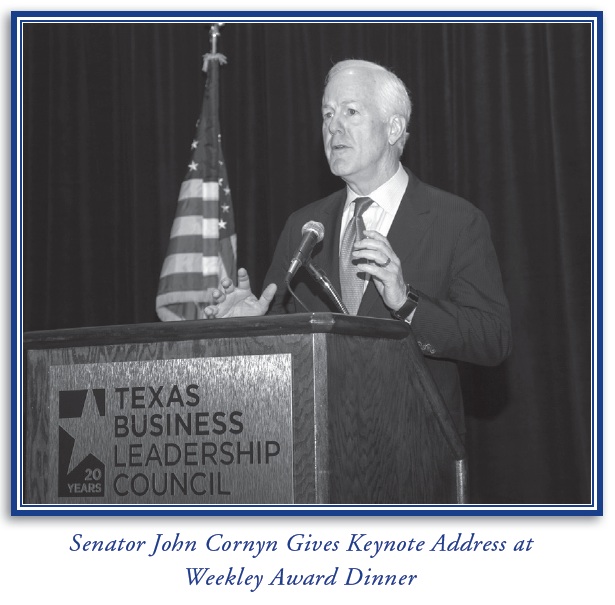
TLR Board member Shad Rowe said that Weekley’s work on lawsuit reform did more than establish fairness and improve the business environment. “It created a model for effecting change in a civil society. We live in a very legalistic, bureaucratic special interest world and it’s not enough to have a good idea, you’ve got to get it implemented … TLR is not just a think tank, we are a do tank.”
San Antonio’s Red McCombs added: “Knowing there was a problem was easy. Anyone could see that. But someone to come in and commit himself to twenty hours a day and never ever give up, to get the right people on the bench, to get the right people in the Legislature, to get the right changes in the laws to where we had a fair chance if we had an issue and still, at the same time, take care of those who had been harmed in a fair way. Dick Weekley was the man. You couldn’t pay somebody to do what he did. Nobody would work that hard. No one would be that effective. He not only spent eighty hours a week working on it, he put a lot of his own personal money into it. God knows we needed Dick Weekley.”
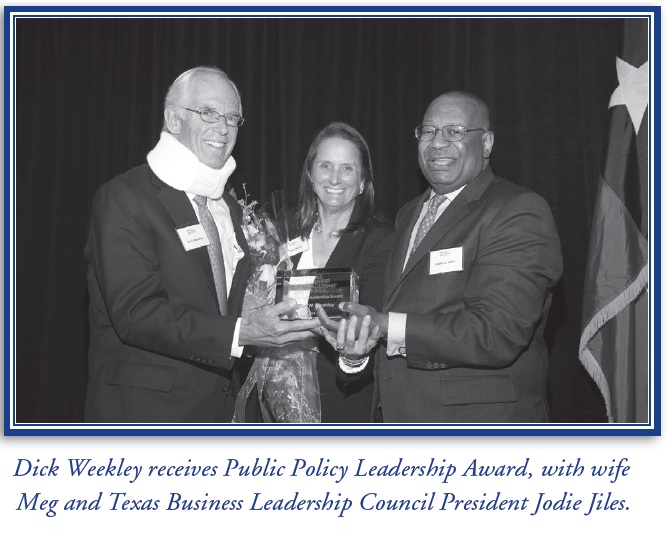
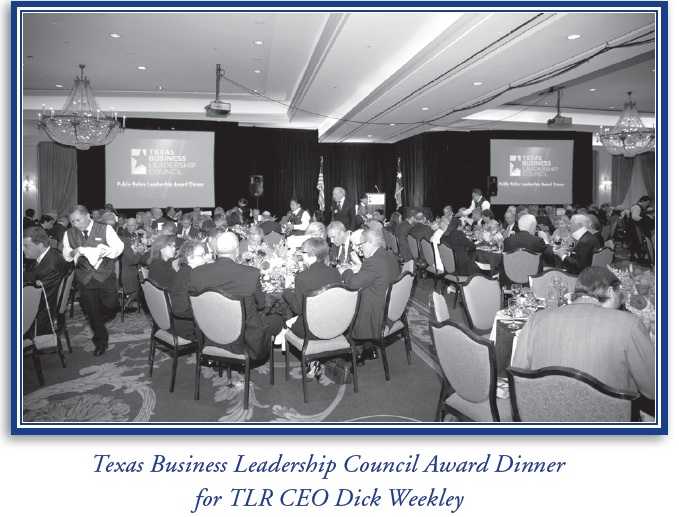
Dr. Richard Stasney called Weekley “a godsend to the medical community,” for his leadership in passing medical liability reforms in 2003.
Ed Wulfe, who worked with Weekley on the Quality of Life Coalition called Dick’s work “a game changer” in Houston. “Whether it’s parks, whether it’s transportation, whether it’s enhancing freeways and creating more green space, across the city you can see where he has touched and made a difference, and it’s forever.”
Former Mayor Bill White called Weekley “the best ally you can have” and added, “He won’t stop until he gets something done.”
TLR Strategist Denis Calabrese, who has been with TLR since its inception, summarized the impact of Dick’s work on the state of Texas:
“Dick Weekley has arguably made the single most impact of any individual in the past decade and a half. I think we can trace a lot of our economic success in Texas to the soundness of our civil justice system, and taking off the anchor that weighed down our state economically pre-reform. You also have to look at what he’s been able to do through TLR in organizing advocates for the state for a sound free enterprise system. How many people he’s motivated to get involved in the process. He’s just a one-man renaissance of ideas and energy and force in the state. And he did it from the private sector, not as an elected official, just somebody with the moral certainty to do the right thing for the state, not caring about who takes the credit, and then always moving onto the next problem, never being satisfied. I just think it’s beyond remarkable. If we had fifty Dick Weekleys, we could fix this country. I’m happy that the one that we have is in Texas.”
Freedom & Prosperity for All
By Alan Hassenflu,
Board Member, Texans for Lawsuit Reform
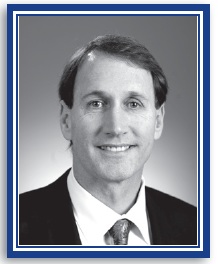
Freedom and Prosperity—Freedom and Prosperity. Not for the privileged few, but for all. This is what America was founded upon and why we exist. Unfortunately, we’ve taken a turn away from these two great ideals over the last several years; in fact, some would say, over the last 50 years, since the “Great Society” federal government concepts of the LBJ administration ushered in vast “entitlement” programs that started to erode our freedom and prosperity that make us exceptional among nations.
What maximizes Freedom? Limited Government. All forms of government—local, state and federal—either work to limit or maximize their reach and scope. By definition, every law, every regulation, every new tax serves to reduce our freedom. However, we need government, so what is the right amount? Our Founding Fathers, those brilliant and brave men, believed that the best government was limited to basic duties such as protection (police, military, private property); establish the rule of laws and courts (criminal and civil); and establish a common currency. These duties were needed to provide for the general welfare, and therefore were to be paid by the public through equal taxation of its citizens. It is reasonable and easy to understand how these duties are for the common good and should be paid by all. However, the massive growth of government since our founding leaves most of us baffled by how it occurred.
Government growth occurred through continual and gradual creep, primarily over the last 80 years commencing with the Social Security Act of 1934. It was at this time that the concept of “entitlements” entered into government lexicon by FDR. The Act barely passed, and passed because America was reeling from the Great Depression and unfortunately had a greater concern for security than liberty at that time. The result of this Act was that, for the first time in our history, the government picked winners and losers for forced taxation. Obviously, the first Social Security recipient paid nothing into the system, and subsequent recipients, to this very day, have received far more than they ever paid into the system. This pernicious concept also produced a mind-set within our country that other “special” classes of citizens should also receive transfer payments. Today, health care, food stamps, disability benefits and corporate welfare in the form of tax credits and subsidies are rife with corruption and gamesmanship pervasive throughout each of these programs. We must act together to commence the repeal or reform of these entitlement programs so our country can return to the concept our Founders envisioned—individual rights and responsibilities, not group rights with no responsibilities.
With regard to Prosperity, there is only one economic structure that has proven time and time again to maximize such, and that structure is free market capitalism. The reason capitalism maximizes prosperity for ALL is because of human nature. The butcher, baker and software creator all trade with one another and receive the benefit of each other’s efforts by maximizing the quality and quantity of their product. Competition among individuals and entities creates increasingly more and better products and businesses, which in turn create more and better jobs and opportunities for employment among our citizenry. This is how America has a total economy more than twice the size of the second largest economy in the world, China, and per-capita productivity more than 8 times that country’s output. Moreover, we have the benefit of seeing how national experiments in the opposite direction—socialism—have failed dramatically over and over again. The Soviet Union, North Korea, Cuba, and more recently, Venezuela, have each seen their economies decline into an abyss of low productivity, food rationing, despair and eventually collapse. The Soviet Union spent 80 years trying to make socialism work, until it collapsed in utter failure in 1989. Whenever governments implement socialism (government control) in any economic area as a substitute to free market capitalism, prosperity and productivity will always start and continue to decline. When this occurs, we must rise up as informed voters and citizens and loudly proclaim that we reject any attempt to stop America from continuing its world role of the bastion of Freedom and Prosperity for all to see and emulate. Limited government and free market capitalism are the only avenues to maximize these concepts for all of us. If we keep these great concepts as a litmus test in all we do, America’s best day are definitely ahead of us.
Who Opposes Tort Reform?
By Richard J. Trabulsi, Jr., President of TLR
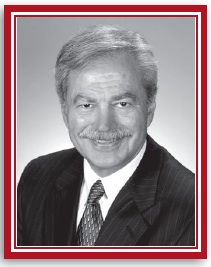
As TLR recognizes its twentieth anniversary in 2014, we are gratified that our efforts and our successes are shared by a sweeping array of Texans—professionals, community leaders, business men and women, teachers, homemakers, ranchers—in other words, the deepest possible cross-section of Texas society.
Who are our opponents? A small group of personal injury and mass tort plaintiff lawyers whose self-aggrandizement is enhanced by friendly politicians and judges. The political action committees engaged in Texas politics in opposition to candidates who support tort reform are largely funded by a few plaintiff lawyers, such as Steve Mostyn, Lisa Blue Baron, John Eddie Williams and Mikal Watts, who are among the largest funders of liberal Democrats. In a new twist, plaintiff lawyers like Mark Lanier and Tony Buzbee are trying to influence the selection of candidates in Republican primaries, especially in judicial races. t
Mark Lanier fielded three candidates against highly respected Texas Supreme Court incumbents in this year’s Republican primary—fortunately, all three of his candidates were soundly defeated, thereby preserving the integrity of Texas’s highest court. But the callousness of his attempt to elect judges friendly to his interests is reflected in the inferior quality of his candidates—for example, Joe Pool who ran against Justice Jeff Brown. Pool has never held a judicial position, is not considered to be an accomplished lawyer, and was required to pay steep penalties by both a trial court and an appellate court for pursuing “groundless claims.” In contrast, Jeff Brown is a seasoned and admired judge, known for his intellect. This stark contrast speaks volumes about the motivation of Lanier in trying to replace an impartial and competent judge with someone of Lanier’s own choosing, no matter how unqualified for the bench.
Tony Buzbee is another personal injury trial lawyer who is engaging in Republican politics to influence judicial selections. He is especially active in Galveston County, where he files many of his fee-generating lawsuits. To tell you the kind of plaintiffs’ lawyer Buzbee is, consider his public brag to a conference of defense lawyers and claims adjusters about a particular trial judge in South Texas:
“Generally speaking, if the judge will give me two hours, which I can generally get from the particular judge in Hidalgo County, I can knock out all those jurors. [Inaudible] I’ve busted several panels, by that I mean knocked out jurors that are favorable to your case, that are against me. And the Hidalgo County judge is going to give me my two hours; that’s enough to knock out jurors and then you’re left with a jury who is favorably disposed to the case.”
In other words, Buzbee looks for judges who will allow him to manipulate jury selection in a way to benefit Buzbee’s case.
Steve Mostyn is the plaintiffs’ lawyer who is spending more money than any other in Texas politics. He often hosts fundraisers for some of the nation’s most liberal politicians and reportedly has pledged ten million dollars to help Democrat Wendy Davis in this year’s gubernatorial race. Mostyn made hundreds of millions of dollars in harvesting thousands of property claims after Hurricane Ike. Those claims were consolidated in Democrat Judge Susan Criss’s courtroom in Galveston County and Mostyn, in clever maneuvers and utilizing problematic statutory provisions, intimidated the Texas Windstorm Insurance Association (TWIA) into vast settlements that enriched Mostyn, at the expense of the State’s now-insolvent windstorm insurer. Fortunately, at TLR’s urging and with strong support from Governor Rick Perry, the Legislature in 2011 passed significant TWIA reform, which improves the claims processes of TWIA and modifies the unfortunate statutory provisions that gave Mostyn so much leverage against TWIA.
The trial lawyers who actively oppose tort reform are the slightest sliver of Texas society. But they are powerful and persistent, and they have a compelling motivation—they create their wealth in courtrooms and they benefit from friendly or incompetent judges and biased or sloppy statutes. These are tort reform’s enemies.
So, how could I close but with Winston Churchill’s rumination: “You have enemies? Good. That means you’ve stood up for something, sometime in your life.”
Jury Trials Declining for Reasons Unrelated to Tort Reform
By Mike Hull, TLR Outside Counsel

Jury trials are declining in America. This decline is occurring in both federal and state courts, in civil and criminal matters, in states with tort reform and in states that have not passed tort reform. The reduction in jury trials began well before the passage of the tort reforms supported by TLR, starting in 1995.
No empirical study links the declining number of jury trials to any specific factor. Many argue that the reduction is attributable to the anxiety of risk and uncertainty in litigation, exorbitant legal costs, the rise in the use of mediation, arbitration and other alternative dispute resolution mechanisms, and the growing role of judges as case managers to resolve lawsuits prior to trial.
TLR has taken an active role in supporting the right to trial by jury by working to reduce the uncertainty of litigation, to contain legal costs and to reduce the time to litigate small claims.
THE DECLINE IN JURY TRIALS
Chief Justice Nathan Hecht of the Texas Supreme Court noted in 2005 that the “number of jury trials is dwindling in Texas, in the federal courts, and in other jurisdictions across the country.” He wrote that the decline in jury trials was occurring in both civil matters (excluding cases involving family matters or juveniles) and in criminal matters.
U.S. Fifth Circuit Judge Patrick Higginbotham noted that the decline in civil jury trials in federal courts has been occurring since at least 1971. Marc Galanter argues in the Stanford Law Journal that there is evidence showing a century-long decline in jury trials in federal courts and state courts, and in criminal and civil trials.
Hecht has demonstrated that “[t]he federal courts tried fewer cases in 2002 than they did in 1962 while disposing of over five times as many civil cases and over twice as many criminal cases.”
Higginbotham noted that in 2000 the average federal district judge would have tried only nine civil cases per year and only seven criminal cases per year. A recent article in the December, 2013 issue of the Texas Bar Journal notes that in 2010 a federal district judge tried, on average, only four civil matters per year. The article further notes that in the period of 1986 –2008, civil jury trials in Texas fell by sixty percent.
Some may claim that tort reform has caused a decline in civil jury trials but, as Hecht has noted, the impact of tort reform on the decline in jury trials has not and likely cannot be measured with any degree of accuracy.
The American College of Trial Lawyers listed tort reform as a tenth factor out of twelve reasons for the decline in jury trials, based on the anecdotal experience of its members. The decline in trials is not limited to cases tried to a jury. Recent data also shows a decline in bench trials, that is, trials before the judge as opposed to trials before a jury.
REASONS FOR THE DECLINE IN JURY TRIALS
As Higginbotham contends, the decline in jury trials is occurring because the “people are dialing out of the system” because of the high expenditures of money, time and energy involved in litigation.
My own courtroom experience mirrors the conclusions of Hecht, Higginbotham and Galanter. Clients are increasingly wary of trying cases with uncertain results, long delays and huge costs and are happy to look for alternative methods to resolve disputes, especially when the judge is pushing for a settlement. As Bill Wagner, Former President of the Association of Trial Lawyers of America has noted, “If the system is designed to get fair and just results, in a reasonable time, and at a reasonable expense, the current system in many cases produces what the client wants.”
TLR HAS CHAMPIONED THE RIGHT TO TRIAL BY JURY
TLR has a long history of supporting the right to trial by jury. TLR has supported measures that reduce the uncertainty of litigation while assuring fair compensation to claimants pursuing meritorious claims. The regulation of punitive damages in 1995 was a huge step in this process. As Higginbotham noted, punitive damages are a wild card in the litigation process. Reining in the risk of a runaway punitive damage award allows parties to evaluate the value of a case based on its inherent merits. The cap on non-economic damages in medical liability lawsuits supported by TLR serves a similar purpose. The “paid or incurred provision” also adds certainty to calculating a damage award by stating that only medical expenses (past and future) actually paid or owed are to be included in damage awards. TLR supported legislation that provides for the prompt resolution of claims of up to $100,000 with substantially reduced pre-trial costs. This measure should increase the opportunity for litigants to go all the way to trial in cases that would be too costly to pursue but for the expedited treatment allowed under Governor Perry’s Omnibus Tort Reform Bill of 2011. The jury trial continues to be on the decline for numerous reasons unrelated to tort reform. TLR will continue to uphold the right of Texans to access our State’s courts, and we will continue to support measures to resolve disputes in ways that reduce the unpredictability, time and cost associated with dispute resolution.
Connect the Dots: Texas Supreme Court Ends Junk Science in Courtrooms and Draws a Political Challenge from Wealthy Plaintiffs’ Lawyers
By Lee Parsley, TLR Outside Counsel
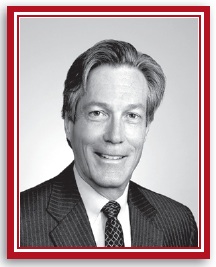
One of the most important Texas Supreme Court decisions in the last 20 years was the Court’s 1995 decision in E. I. du Pont de Nemours & Co. v. Robinson, limiting the use of junk science to prove causation in tort cases. In a roundabout way, that decision now is under attack by a few of Texas’s wealthiest plaintiffs’ lawyers.
Whether a defendant’s action caused a plaintiff ’s injury is often the make-or-break issue in litigation. In many cases, this causal connection must be established through technical or scientific evidence. This evidence typically takes the form of testimony by an expert witness, like a medical doctor, chemist, or engineer. In the past, these experts often would testify based on his or her knowledge, education, and experience, coupled with observations, experiments, or studies made or conducted by the witness. Often, however, these observations, experiments, or studies were not reliable, scientifically speaking. It was “junk science.”
Robinson banned unreliable technical and scientific evidence from Texas courtrooms. Under Robinson, technical and scientific evidence must be based on peer-reviewed studies conducted using the scientific method. After Robinson, it is no longer acceptable for a hired-gun expert to provide unsupported testimony based solely on her knowledge, education, or experience; or based on observations, experiments, or studies that were not scientifically valid.
The question of whether scientific evidence presented at trial meets the Robinson standards is a question of law made by the trial judge and reviewed by appellate courts if a challenge to the evidence is part of an appeal. So, while it is important that trial judges make the correct decision on the admissibility of expert testimony, uncompromising appellate review is critical. Robinson reflects the common-sense idea that scientific evidence must be based on real science, not on speculation, conjecture, or rigged experiments by a hired-gun “expert.” It helped put Texas at the forefront in the battle against the use of “junk science” nationwide.
Robinson and the decisions that follow it are a thorn in the side of many personal injury trial lawyers, including Houston’s Mark Lanier.
Robinson, for example, applies to asbestos litigation. Litigation in which the claimants allege asbestos-caused diseases constitutes the nation’s longest-running mass tort. Over the past 40 years, the judicial system nationwide has grappled with hundreds of thousands of plaintiffs claiming an asbestos-caused disease, but showing no sign of illness. In Texas, Mark Lanier and other plaintiff lawyers had filed thousands of lawsuits on behalf of plaintiffs claiming a non-impairing asbestos illness, typically diagnosed from x-rays taken in discount-store and union-hall parking lots by x-ray readers hired by plaintiffs’ lawyers.
In 2007, the Texas Supreme Court held in Borg-Warner Corp. v. Flores that Robinson applies in asbestos cases. Consequently, asbestos plaintiff lawyers like Mark Lanier had to start proving an actual scientific connection between asbestos exposure and their clients’ alleged diseases.
Lanier also was heavily involved in litigation throughout the nation related to the pharmaceutical Vioxx. Lanier represented plaintiffs who claimed they suffered various heart-related problems after taking Vioxx. Lanier had won a jury trial in Brazoria County against Merck, the manufacturer of Vioxx. The jury awarded his client over $253 million in damages. Lanier, however, lost the Brazoria County case at Texas’s Fourteenth Court of Appeals in 2009 because his evidence was insufficient under Robinson to prove causation ( Merck & Co. v. Ernst).
Lanier’s theory in Ernst was that Vioxx created a blood clot that caused the plaintiff ’s husband to have a fatal heart attack. An autopsy, however, did not reveal a blood clot. To explain the missing blood clot, Lanier’s hired-gun medical experts testified that the blood clot might have dissolved after death or might have been dislodged or broken-up by CPR. Unfortunately for Lanier, his experts provided no scientific support for the idea that a blood clot could dissolve after death or that CPR could dislodge or break-up a blood clot. In other words, his case was built on junk science that was admitted into evidence by a trial judge reputed to be friendly to Lanier. The court of appeals disallowed the junk science and reversed the judgment.
Subsequent to Ernst, the Robinson standard was applied by the Texas Supreme Court in another Vioxx case, in Merck & Co. vs. Garza.
These decisions and others like them appear to have triggered political activity by Mark Lanier and a group of wealthy plaintiff lawyers who typically support Democrats.
In the most recent election cycle, three respected members of the Texas Supreme Court were challenged in the Republican primary while seeking re-election to their positions—Chief Justice Nathan Hecht, Justice Phil Johnson, and Justice Jeff Brown.
Chief Justice Hecht was the author of the Court’s opinion in Garza and joined in the Court’s decision in Borg-Warner. Justice Johnson joined in the Court’s decisions in Garza and Borg- Warner. Justice Brown was a member of the Fourteenth Court of Appeals at the time it considered Ernst, and he served on the three-judge panel that reversed Lanier’s judgment in that case.
Mark Lanier—and a group of Texas’s richest plaintiff lawyers—financed Republican primary challengers to the three incumbent justices. Fortunately, the three incumbent justices all won the Republican nomination by large majorities, despite Lanier’s funding of their opponents.
Lanier, and the Democrat personal injury trial lawyers who are helping him challenge conservative Supreme Court justices, are doubtless hoping they can create a critical mass of justices on the Texas Supreme Court who will vote to reverse or water-down Robinson and allow “junk science” back into Texas’s courtrooms. If they are successful, Texas courts will return to the days when speculation, conjecture, and rigged experiments by a well-compensated “scientist” will replace real science in Texas’s courtrooms. This is an effort the supporters of the rule of law should vigorously oppose, whether the effort arises in the courts, in the Legislature, or in the form of attempts to oust highly qualified jurists. ■


